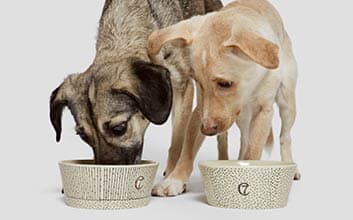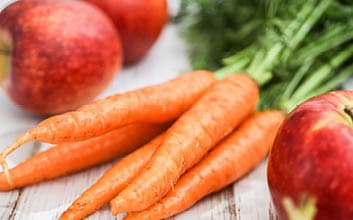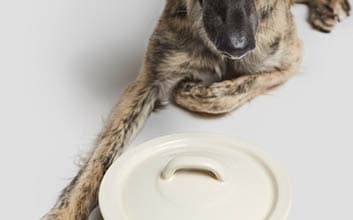Guide to Dog Food: How to find the right diet for your dog
Does my dog need a change in the food bowl?
Even if it is almost unimaginable for us humans: no. Many dog owners tend to humanize their four-legged friends. But for dogs it is not at all bad to eat the same dish every day. On the contrary - with dogs it is not only that this does not bother them, it is even much more tolerable for the sensitive stomach, because otherwise there is always a change. You will find more information on changing your dog's diet in the rest of the guide under the heading "How does the change in diet work".
 Cloud7 Dog Bowl Yoji Stripes and Yoji Dots
Cloud7 Dog Bowl Yoji Stripes and Yoji Dots
How often and how much should a dog be fed?
Opinions differ on the subject of frequency and dosage. While some four-legged friends get a smaller portion of dog food three times a day, most dog owners decide on two meals a day, one in the morning and one in the evening, as soon as the darling has left puppyhood. At best, you should make the time of day dependent on your walks. It is highly recommended to feed the dog only after the walk to avoid any stomach twisting caused by playing and frolicking with a freshly filled stomach.
It may be useful for you to know that the feeding recommendations regarding the dosage on the respective pack of your dog food refer to the entire daily ration unless otherwise noted. This number of grams in relation to body weight must therefore be divided into the various individual portions depending on how often you feed your dog. If your dog is active above average, it may be a little more than the dosage recommended. In most cases, you will be surprised that you would intuitively give your dog far too much food. However, dog food - especially dry food - is very rich, which is why you can have complete confidence in the dosage for your dog stated on the pack.
For the sake of your dog's well-being, you should also always take it seriously to ensure that he has a healthy weight and a balanced diet. Most dogs have a lively and active appetite, so you can't expect them to stop eating once they've had enough. As a dog owner, it is therefore your responsibility to portion your dog correctly. Excessive amounts of food can have dramatic consequences of overweight, such as liver damage, heart problems, slipped discs, sluggishness, joint problems and osteoarthritis. It is important to prevent this overweight as much as possible from an early age.
Which dog food is healthier for my dog - dry food and wet food in comparison
If you have already looked at other guides, you will know Every dog has its own demands and unfortunately, generally valid answers in the field of pets are very rare. Also, not every dry food can be used to determine the general compatibility of dry food with your dog. For this reason, the following text will guide you step-by-step through the many options, and then give you a more detailed overview of the numerous possibilities depending on your dog's needs. Hopefully this will make it easier for you to make a decision.
In general, the following applies: The selection of a high-quality manufacturer as well as gentle preparation with selected, natural ingredients in combination with the necessary minerals and vitamins is the top priority. Regardless of the type of food and the respective nutrients, the main ingredients as well as the meat content of the food are of course also relevant for suitable dog nutrition:
Popular ingredients for dog food
- Duck
- Lamb
- Beef
- Salmon
- Chicken
- Venison
- Sweet potato
- Potato
- Rice
- Pumpkin
- Berries
Well-tolerated meat and ingredients for sensitive animals
- Chicken
- Kangaroo
- Horse
- Fennel
- Carrots
 Herbs for high-quality dog food
Herbs for high-quality dog food
Important information about dry food as dog nutrition
Dry food as a complete food is probably the type of dog nutrition that is associated with the least effort in feeding. It can be stored easily and for a long time, is available in large containers and can also be taken along on journeys without any problems, for example in a storage tin. On the one hand, many dog owners swear by dry food, because very high-quality variants are available at a comparatively lower price than wet food. In addition, chewing the solid pellets strengthens the jaw muscles and cleans the teeth of plaque at the same time. To support your dog's adequate fluid intake, the croquettes can be briefly soaked in water before feeding.
The composition of the pellets (also called croquettes) of most types of dry food has a meat content of about 50% while the second half consists of ingredients such as vegetables, herbs, vegetable fats, potatoes, rice or similar ingredients as well as minerals such as mussel extract to strengthen the bones. At best, the meat is lean muscle meat or offal from species-appropriate animal husbandry. Dried fodder contains a maximum residual water content of 14 percent, so that it can be kept for a particularly long time when stored in a cool, dry place.
The large selection of dried food can be divided not only into different flavours, but also into other diverse possibilities:
Different types of preparation
- Cold pressed dog food is particularly gentle on the original, natural ingredients (processing by pressure instead of heat).
- Extruded dry food is obtained through heat - vitamins can be lost through warm water vapour, which is why synthetically produced and therefore less valuable vitamins are added later.
Different types of pellets in dry dog food
- Round croquettes
- Elongated pellets
- Different croquette sizes for small and large dog breeds
Different types of dry food for dogs according to life phase and activity
- Puppy food and Junior food: Particularly nutritious to meet the special nutritional requirements of growing dogs.
- Adult dog food: Dry food for averagely active dogs.
- Senior food: Addresses the sensitive gastrointestinal tract and restricted movement patterns of older dogs.
- Sensitive food: Easily digestible and also suitable for dogs with allergies due to especially compatible ingredients.
- Active food: Supplies active dogs with additional energy.
- Light food: Supports dogs with overweight when losing weight in order to protect the joints.
 Meet, vegetables and cold-pressed oils
Meet, vegetables and cold-pressed oils
What does wet food consist of? Wet food for dogs at a glance
Many dog owners associate wet food and canned food with unpleasant odours and flatulence in their dogs. Here the ingredients are usually more clearly visible than with dry food, which is why wet food is often considered to be of higher quality. Unfortunately, this is often not really true: What is called fish, beef or lamb often contains just four percent "real" meat of food quality. The rest is mostly inferior waste and inexpensive means of stretching. These are then described on the packaging as "animal by-products".
In the meantime, a large market has opened up alongside these rather sad wet food variants in terms of ingredients, which itself offers a wide variety of wet food in organic quality for dogs. Surprisingly, some of the high-quality wet food, which is usually offered in tins of 400 grams or 800 grams, comes surprisingly close to home-cooked dishes. A lot of fresh meat as well as fruit and vegetables are processed and finally supplemented with healthy ingredients such as rice, sweet potatoes and essential fatty acids to create a balanced meal. The fact that this type of canned food can even smell pleasant is probably only one of the innovations of recent years.
Most wet food for dogs can be kept for about two days after opening the can and must then be kept in the refrigerator. However, depending on the size of the packaging unit, most dogs should be able to consume this quantity within this period without any problems. However, a small disadvantage of wet food is that it can quickly become quite expensive if a high-quality product is chosen.
What does BARF actually mean and how do I BARF?
The abbreviation stands for Bones and Raw Foods. The food is exclusively uncooked and therefore retains all the important vitamins and minerals. BARF not only offers raw fresh meat but also raw, pureed fruit and vegetables. This feeding method is considered the most natural form of nutrition for dogs.
In order to cover the dog's complete nutritional requirements, he needs food supplements in addition to meat, fruit and vegetables, which are also put into the bowl. Oils for the omega-3 balance and digestion as well as other powders such as mussel extract or seaweed round off the menu to create a healthy, digestible and species-appropriate meal. Probably the only disadvantage: BARFing was originally very elaborate in its preparation. Therefore, it is very pleasant that there are not only specialized BARF butchers who can help you with the selection and preparation, but that there are also some frozen and easy to portion BARF dishes available in well-assorted specialist shops. So the BARF meal only has to be defrosted and then served to the dog in the bowl.
Compared to fresh meat, deep-frozen meat can usually be the safer option, as it prevents salmonella and other pathogens. Special hygiene is nevertheless enormously important with BARFing. Due to the high risk of infection, we strongly advise against feeding raw pork or pork bones.
Well-tolerated types of meat for BARFing:
- Beef
- Deer
- Horse
- Kangaroo
Even if the focus of BARFen is on raw meat, care should generally be taken not to feed too much meat. Otherwise the dog will consume too much protein and phosphorus, which can lead to kidney problems. Bones should also only be fed in moderation, as they are difficult to digest if your dog is not used to eating them. Otherwise it can lead to severe digestive problems, white feces and chronic constipation. Herbal substances on the other hand should by no means be too low. The dietary fibres usually contained in fruit and vegetables support the dog's digestion and should therefore be taken into account.
Recommended food supplements for BARFing:
- Oils for good digestion, healthy skin and shiny coat; e.g. linseed oil, salmon oil, hemp oil
- Mussel extract to strengthen the bones; e.g. green-lipped mussel
- Algae as natural iodine suppliers; e.g. seaweed, kelp
 Naturally processed dog food
Naturally processed dog food
What makes high-quality dog food
A high quality dog food works with food quality products and above all avoids slaughter waste and so-called animal by-products. As with high-quality food for humans, artificial ingredients and sugar should be avoided. Important, however, are valuable proteins, for example from muscle meat, fillets of various types of meat or fish fillets, and the use of as little animal fat as possible. High-quality vegetable oils such as linseed oil, hemp oil or salmon oil with a high proportion of omega-3 fatty acids are more than welcome: These promote healthy digestion, beautiful skin and a shiny, soft fur.
Many inferior dog foods use wheat and other cheap grains as fillers. Carbohydrates that are better suited to the needs of dogs are found in primary cereals such as rice, buckwheat, millet or amaranth. Potatoes, sweet potatoes and pumpkin are also very well tolerated and provide important vitamins and fibre at the same time. For the same reason, nutritious fruits, vegetables and grasses as well as natural extracts should not be neglected as a source of calcium.
For the sake of clarity, here is a summary of high-quality dog food at a glance:
- Fresh meat or fish in food quality as protein source
- No artificial additives and no sugar
- Vegetable oils for healthy digestion, skin and beautiful fur coat
- No wheat or similar cereals without nutrients
- Vitamins and minerals from fruit, vegetables and grasses
Vegetarian and vegan dog food
The interest in vegetarian and vegan nutrition as part of a sustainable lifestyle is growing and growing. The fact that the inhabitants of these households would therefore also like to feed their pets in a way that is as resource-friendly as possible is very commendable.
Although dogs are prey eaters in evolutionary terms, they also love many dairy products such as granular cream cheese, curd cheese or chicken eggs. Colourful vegetables such as beetroot and spinach also go down very well with dogs, providing them with much-needed nutrients.
A completely vegan diet consisting of pure fruits and vegetables instead of a combination with meat or fish would probably not be sufficient for a balanced dog food full of nutrients. However, for some time now there have been particularly innovative companies offering vegan dog food with high-protein lupins and lentils. Cooked in combination with the right herbs and additives, these are not only considered to be extremely environmentally friendly and rich in dietary fibre, but also extremely well tolerated by puppies and seniors.
Another really exciting option is a new type of insect-based dog food. Although this is neither vegetarian nor vegan, it is also considered a sustainable source of protein with a good ecological balance. It is also very popular with most dogs.
 Carrots are very easily digestable
Carrots are very easily digestable
What to feed with digestive disorders?
Veterinarians recommend feeding small portions of easily digestible food for digestive problems such as diarrhea. For example, chicken breast cooked in water or some vegetable broth in combination with rice or potatoes is suitable. Grated carrots or the so-called Moro's Carrot Soup can also help to bring your quadruped's digestion back to normal.
Recipe for Moro's carrot soup
For decades, Moro's carrot soup has been considered one of the best household remedies against diarrhoea: It can also be given to your dog instead of the normal food in case of complaints. Carrots are washed, peeled and cut into small pieces. Pour the carrots into a large pot with enough water and let it simmer for at least 90 minutes. Over time, certain sugar molecules are released which act as a binding agent. When the cooking time is over, puree the carrots with some cooking water and season with a small amount of salt. The finer the soup is pureed, the better the released sugar molecules reach the intestinal wall. When ready, the consistency should remind you of thick buttermilk. Moro's carrot soup is best served hand-warm or completely cooled down.
In the event of such complaints, it may also be helpful to give your dog many small portions of food spread out over the day to minimise the strain on his sensitive stomach.
An important note at this point: If the symptoms persist, you should definitely consult a vet. This guide is not a medical text.
How does the change of food work?
As mentioned at the beginning of this article, dogs cannot cope with frequently changing food due to their sensitive stomachs. Therefore, a change of diet should at best last a total of ten days. To do this, gradually add some new food to your dog's usual diet and increase the amount of food in slow steps each day. In this way, the dog food should be changed without causing digestive problems such as diarrhea.
Treats and dog snacks
What's the point of treats?
Reward, training or keeping them busy: The reasons for giving your dog a treat besides his complete food are different. Depending on their shape and size, they can be used, for example, for training tricks and leash handling, as a reward after retrieving them during a walk or as a challenge lasting several minutes if the dog needs to be distracted or amused while you are having an important conversation yourself. When giving out treats, please take care to develop a healthy mediocrity so that the dog is not challenged or overfed. In general, the amount of treats given should be deducted from the daily ration of the main food to prevent you from becoming overweigh.
Ingredients of dog treats
Make absolutely sure that there is no sugar in the dog treats. Many cheap suppliers work with sugar - this tastes very good to the dogs and at the same time it ignites addiction potential. However, even more problematic than snacking on sweets is the fact that very few dog owners regularly brush their dogs' teeth. This means that in addition to unhealthy overweight, caries and tartar quickly develop. Their removal at the vet is not only very cost-intensive, but above all extremely unpleasant for your pet. Better than small treats in between would be natural dried meat or sugar-free baked treats, which can be given an attractive taste, for example, by herbs or apples.
Different types of dog snacks
Very popular as a snack in between meals or as an occupation during a restaurant visit are completely natural and therefore relatively harmless dried animal ears. These include pig ears, lamb ears or rabbit ears. Also dried bull whips, horse skin, cattle skin, esophagus of various animals and sticks from rumen are enjoyed by many four-legged fans, because they need a while until the dog snack is completely plastered. Please note that you should not feed this kind of treat to your darling unattended, as there is a risk of injury due to possible sharp edges.
As already mentioned, natural dried meat snacks are a more fast-moving treat, but also dried fish such as sprats or dog biscuits. In order to keep your dog happy during a walk, you can also pack your dog's usual dry food in addition to small pieces of dried meat and always keep it in a bag of treats for a reward.
 Cloud7 Dog Bowl Granny with lid
Cloud7 Dog Bowl Granny with lid
What you should not feed your dog
Not everything that people find tasty is automatically suitable for dog nutrition. Sometimes even small amounts can become poisonous for four-legged friends, which is why absolute caution must be exercised with the following foods:
- Poultry bones (danger of splintering)
- Raw potatos
- Rohe pulses
- Avocado
- Aubergines
- Tomatoes
- Onions
- Fruit stones
- Grapes or raisins
- Star fruit
- Sweeteners
- Nuts
- Chocolate or cocoa
- Caffein
- Alcohol
Food prepared for humans, i.e. spiced or fried food, is also not suitable for dogs. The four-legged friends have an extremely sensitive stomach and should never be used as a leftover. Even though your dog may look sweet and it may cost you quite a bit of effort to resist the gaze, the focus should be clearly on the health of your pet. And unfortunately, as this article shows, this does not include sweet or savoury food for humans.
However, if you follow the article and regularly consult your vet when in doubt, there's really nothing standing in the way of a healthy, happy pet, both inside and out. Bon appetit!
